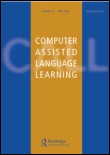
Computer Assisted Language Learning
Scope & Guideline
Innovating the Future of Language Education
Introduction
Aims and Scopes
- Technology-Enhanced Language Learning:
The journal emphasizes research on how technology, including mobile applications, online platforms, and virtual reality, can enhance language learning outcomes and experiences. - Artificial Intelligence and Language Learning:
A significant focus is placed on the application of AI, such as automated feedback systems and chatbots, to support language learning, improve writing skills, and facilitate learner engagement. - Digital Multimodal Composing:
Research often explores the role of digital tools in multimodal composing, allowing learners to express language skills through various formats, including text, video, and audio. - Informal Digital Learning:
The journal examines informal learning contexts, such as social media and gaming, and their impact on language acquisition, highlighting the role of learner autonomy and motivation. - Collaborative Learning Environments:
CALL promotes research on collaborative learning facilitated by technology, including telecollaboration and peer feedback mechanisms, to enhance interaction and language proficiency. - Assessment and Feedback Mechanisms:
Research on the effectiveness of various assessment methods, including dynamic assessment and automated feedback, is a core area, focusing on how these tools can improve learner outcomes.
Trending and Emerging
- Gamification in Language Learning:
Gamification is increasingly recognized as a powerful tool for enhancing learner engagement and motivation, with research exploring its effectiveness in various language learning contexts. - Integration of Large Language Models:
The application of large language models, such as those used in AI-driven writing assistance, is gaining traction, reflecting a trend towards leveraging advanced technology for improving language skills. - Virtual Reality and Immersive Learning Experiences:
Research on virtual reality (VR) as a means to create immersive language learning experiences is emerging, highlighting its potential to enhance engagement and contextual understanding. - Informal Learning through Digital Media:
The exploration of informal learning environments, particularly through social media and digital gaming, is becoming a prominent theme, emphasizing learner autonomy and motivation in language acquisition. - Emotional and Psychological Aspects of Learning:
There is a growing interest in understanding the emotional and psychological factors that affect language learning outcomes, particularly in digital contexts, addressing learner anxiety and motivation. - Data-Driven Learning and Feedback:
Research focusing on data-driven approaches to learning and feedback mechanisms is on the rise, with studies investigating how data analytics can inform and improve language instruction.
Declining or Waning
- Traditional Language Teaching Methods:
As technology continues to evolve, traditional methods of language instruction, such as grammar-translation and rote memorization, are receiving less attention in favor of more interactive and technology-integrated approaches. - Face-to-Face Interaction in Language Learning:
The shift towards online and hybrid learning environments has led to a decrease in research focused solely on face-to-face interactions, as studies increasingly explore technology-mediated communication. - Static Assessment Tools:
There is a noticeable decline in research centered on static assessment tools, as dynamic assessment and formative feedback mechanisms gain traction due to their effectiveness in supporting learning. - Single-Modal Learning Approaches:
Research emphasizing single-modal approaches, such as traditional reading or listening exercises without integration of multimedia or interactive elements, has become less prominent as multimodal learning gains importance. - General Educational Technology without Language Focus:
While educational technology remains a vast field, specific studies on generic technology applications without a direct connection to language learning are becoming less frequent in CALL.
Similar Journals

Language Teaching
Exploring the future of language pedagogy and applied linguistics.Language Teaching, published by Cambridge University Press, is a premier peer-reviewed journal that has been at the forefront of the linguistics and language education field since its inception in 1969. With an impressive impact factor positioning it in the top tier (Q1) of its category, this journal is ranked 22nd among 1,088 in the Arts and Humanities field and maintains an outstanding 98th percentile ranking. Focusing on innovative research and methodologies in language teaching and learning, Language Teaching provides a vital platform for discussing the latest developments in pedagogy, applied linguistics, and curriculum design. Although it does not offer open access options, it reaches a broad audience of researchers, educators, and practitioners dedicated to enhancing language instruction across various contexts. The journal continues to evolve, with plans to cover emerging trends and challenges in language education until 2024, making it an essential resource for anyone invested in the teaching of languages.

Language Learning in Higher Education
Transforming higher education through effective language learning.Language Learning in Higher Education is a prominent academic journal published by DE GRUYTER MOUTON, dedicated to exploring the intricate dynamics of language acquisition and pedagogical practices within the higher education context. With a robust ISSN: 2191-611X and E-ISSN: 2191-6128, this journal provides a platform for innovative research that addresses contemporary challenges and methodologies in language education. The journal enjoys a favorable reputation in the academic community, as evidenced by its ranks in the Scopus database, where it holds a position in the 67th percentile for Language and Linguistics and is classified in the Q3 and Q2 quartiles across relevant education and linguistics categories. Since its convergence in 2017, Language Learning in Higher Education aims to enrich scholarly discourse by publishing high-quality articles that foster insights into effective language learning strategies, thus serving as an essential resource for researchers, educators, and students committed to enhancing language education. The journal's editorial team is devoted to advancing the field through rigorous peer-review processes and welcomes contributions that push the boundaries of language learning research.

ALSIC-Apprentissage des Langues et Systems d Information et de Communication
Unlocking New Horizons in Language Learning and Technology.ALSIC-Apprentissage des Langues et Systems d Information et de Communication, published by ADALSIC, is a premier Open Access journal that has been at the forefront of language learning and information and communication systems since its inception in 1998. With its ISSN 1286-4986, this journal provides a crucial platform for researchers, educators, and practitioners to share innovative findings and pedagogical practices in the interdisciplinary fields of linguistics, education, and technology. The journal invites contributions that explore the dynamics of language acquisition, the effectiveness of communication systems, and the integration of technology in learning processes. By maintaining an Open Access policy, ALSIC ensures that its valuable research is accessible to a global audience, promoting collaboration and knowledge sharing among scholars and professionals dedicated to enhancing language education and communication methodologies. As an inclusive journal based in Strasbourg, France, it plays a vital role in shaping current discourse and advancing research in its field.
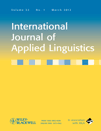
International Journal of Applied Linguistics
Pioneering Research for Language Educators and PractitionersInternational Journal of Applied Linguistics, published by WILEY, is a premier platform for cutting-edge research in the field of applied linguistics. With a notable Impact Factor and ranked in the top Q1 quartile of linguistics and language, this journal serves as an essential resource for scholars, practitioners, and students. The journal’s wide-ranging scope includes various subfields such as language acquisition, language education, sociolinguistics, and discourse analysis, fostering multidisciplinary approaches to language studies. It has achieved a significant Scopus Rank, placing it in the 90th percentile for both Arts and Humanities as well as Social Sciences categories, reflecting its high visibility and influence in the academic community. The International Journal of Applied Linguistics is committed to advancing the understanding of language use in real-world contexts through rigorously peer-reviewed articles that contribute to both theory and practical applications. While it is not an open-access journal, it remains a highly respected publication for researchers looking to disseminate and acquire knowledge in applied linguistics.

Studies in Second Language Learning and Teaching
Exploring innovative paths in second language acquisition.Studies in Second Language Learning and Teaching is a premier open-access journal dedicated to advancing research and scholarship in the fields of education, linguistics, and language acquisition. Published by ADAM MICKIEWICZ UNIVERSITY, KALISZ, this journal has consistently achieved high acclaim, reflected in its impressive Q1 rankings in both Education and Linguistics and Language categories for 2023. With a robust focus on innovative methods, effective pedagogical strategies, and interdisciplinary approaches, Studies in Second Language Learning and Teaching aims to facilitate dialogue among researchers, educators, and practitioners, fostering a deeper understanding of language learning and teaching in diverse contexts. Since its transition to open access in 2011, the journal has expanded its reach, providing valuable resources and research findings to a global audience. With an exceptional Scopus ranking placing it in the top percentiles across multiple categories, this journal stands as a crucial platform for the dissemination of ground-breaking research in second language education.
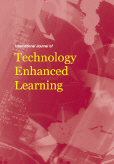
International Journal of Technology Enhanced Learning
Bridging the Gap Between Technology and Effective LearningInternational Journal of Technology Enhanced Learning, published by INDERSCIENCE ENTERPRISES LTD, is a premier scholarly journal that comprehensively explores the intersection of technology and education, fostering innovative approaches to enhance learning processes. Established in 2008 and continuing through 2024, the journal is pivotal for researchers, educators, and technology professionals aiming to disseminate and engage with cutting-edge developments in technology-enhanced learning environments. With an admirable ranking in Scopus—placing in the 72nd percentile of Education and 49th in Computer Science Applications—the journal reflects a robust influence in the fields of Computer Science Applications and Education, as evidenced by its Q2 and Q3 quartile rankings. The journal not only provides a platform for empirical research and theoretical discourse but also emphasizes practical implementations in e-learning. Although it does not offer open access, its curated collection of articles serves as a vital resource for scholars and practitioners who are dedicated to advancing the nexus of technology and education.

Journal of Asia TEFL
Illuminating the Future of English Teaching in AsiaWelcome to the Journal of Asia TEFL, a leading peer-reviewed platform dedicated to exploring the intersections of English language education, linguistics, and the dynamic educational landscapes of Asian contexts. Published by ASIA TEFL in South Korea, this journal has emerged as a pivotal resource for academia since its inception in 2004, with consistently expanding influence reflected in its Scopus rankings, including a notable 76th percentile in Linguistics and Language. With a focus on the evolving methodologies and pedagogical innovations in English language teaching, the journal aims to foster scholarly discussions that enhance teaching practices and policy-making in a globalized world. Although it currently operates without open access, its rigor and relevance in categories such as Education and Linguistics ensure that it remains a valuable asset for researchers, educators, and students seeking to advance their knowledge and practice within this vital field of study.

Language Teaching Research
Exploring innovative methodologies in language learning.Language Teaching Research, published by SAGE Publications Ltd, serves as a pivotal platform for scholars and practitioners in the domains of education and linguistics. Since its inception in 1997, this prestigious journal has maintained its status within the Q1 category for both Education and Linguistics, symbolizing its significant impact and commitment to excellence in research. With impressive Scopus rankings placing it among the top percentile in its fields, Language Teaching Research provides a comprehensive array of articles, studies, and reviews dedicated to advancing the theory and practice of language education. Although currently not an Open Access journal, it remains essential reading for those engaged in the evolving challenges and methodologies surrounding language teaching and learning. The journal aims to foster insightful discussions and disseminate innovative research findings, making it a crucial resource for educators, researchers, and students keen on enhancing language acquisition and pedagogical strategies.
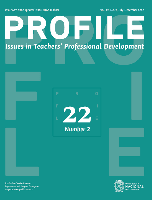
Profile-Issues in Teachers Professional Development
Empowering Teachers: Navigating the Future of Professional DevelopmentProfile - Issues in Teachers Professional Development is a distinguished open access journal published by the Universidad Nacional de Colombia, Facultad Ciencias Humanas, aimed at fostering research and discourse surrounding critical issues in educators' ongoing professional development. Since its inception in 2005, the journal has established itself as a significant resource within the fields of Education and Linguistics and Language, reflecting its relevance through its category quartiles, being positioned in Q3 in Education and an impressive Q1 in Linguistics and Language for 2023. The journal boasts a commendable Scopus ranking, reflecting its impact and commitment to advancing scholarly discussion, with rankings of #236 out of 1167 in Linguistics and Language, and #818 out of 1543 in Education. With a converged timeline from 2018 to 2024, it serves as a vital platform for educators, researchers, and students alike, encouraging the dissemination of innovative practices and insights essential for the evolution of teacher training and professional growth in a rapidly changing educational landscape.
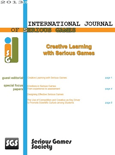
International Journal of Serious Games
Pioneering Interdisciplinary Insights in Serious GamingThe International Journal of Serious Games is a pioneering publication dedicated to advancing the interdisciplinary field of serious games and their application in various domains such as education, artificial intelligence, and human-computer interaction. Published by SERIOUS GAMES SOC in Italy, this Open Access journal has been facilitating unrestricted access to innovative research since 2014. The journal is recognized for its quality, achieving prominent rankings in its categories, including Q2 in Education and Q2 in Computer Graphics and Computer-Aided Design as of 2023. With its commitment to academic rigor, it places itself as an essential resource for researchers, professionals, and students seeking to explore the transformative potential of serious games. Housed at the IST INT COMUNICAZIONI, VILLA PIAGGIO, GENOA, the journal continues to foster knowledge sharing and collaboration across disciplines, enriching the global discourse on gaming for impact.